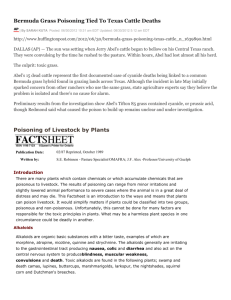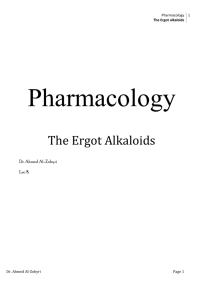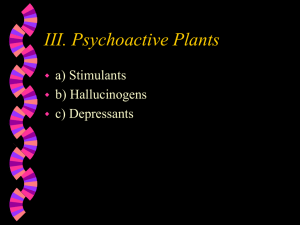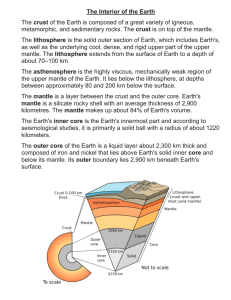Dear Ariane, - Spiral - Imperial College London
advertisement
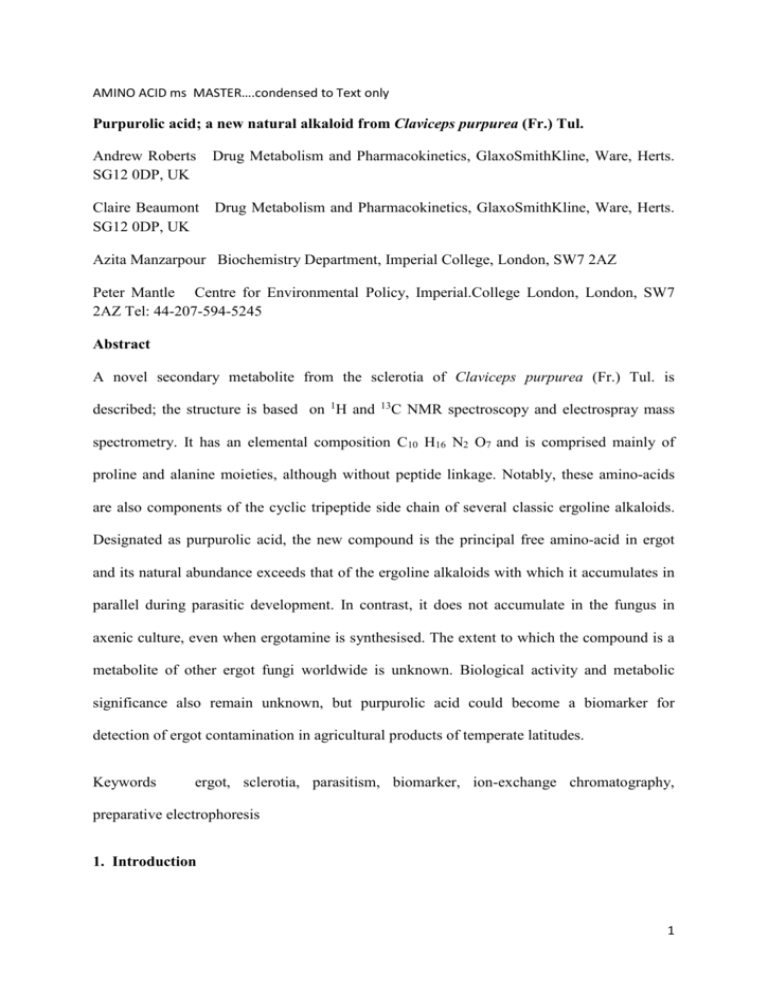
AMINO ACID ms MASTER….condensed to Text only Purpurolic acid; a new natural alkaloid from Claviceps purpurea (Fr.) Tul. Andrew Roberts SG12 0DP, UK Drug Metabolism and Pharmacokinetics, GlaxoSmithKline, Ware, Herts. Claire Beaumont Drug Metabolism and Pharmacokinetics, GlaxoSmithKline, Ware, Herts. SG12 0DP, UK Azita Manzarpour Biochemistry Department, Imperial College, London, SW7 2AZ Peter Mantle Centre for Environmental Policy, Imperial.College London, London, SW7 2AZ Tel: 44-207-594-5245 Abstract A novel secondary metabolite from the sclerotia of Claviceps purpurea (Fr.) Tul. is described; the structure is based on 1H and 13 C NMR spectroscopy and electrospray mass spectrometry. It has an elemental composition C10 H16 N2 O7 and is comprised mainly of proline and alanine moieties, although without peptide linkage. Notably, these amino-acids are also components of the cyclic tripeptide side chain of several classic ergoline alkaloids. Designated as purpurolic acid, the new compound is the principal free amino-acid in ergot and its natural abundance exceeds that of the ergoline alkaloids with which it accumulates in parallel during parasitic development. In contrast, it does not accumulate in the fungus in axenic culture, even when ergotamine is synthesised. The extent to which the compound is a metabolite of other ergot fungi worldwide is unknown. Biological activity and metabolic significance also remain unknown, but purpurolic acid could become a biomarker for detection of ergot contamination in agricultural products of temperate latitudes. Keywords ergot, sclerotia, parasitism, biomarker, ion-exchange chromatography, preparative electrophoresis 1. Introduction 1 Ergot and its alkaloids have extensive history in mycology, plant pathology, pastoral and arable agriculture, human and animal toxicology and human therapeutics (Bove 1970; Berde & Schild 1978). Until the 1960s, medicinal ergot alkaloids were sourced from plant parasitic sclerotia. Research into the biochemistry of ergot at Imperial College commenced in 1960 with the imminent relocation of E. B. Chain from Rome, where industrial-scale fermentation production of ergot alkaloids, by an isolate of Claviceps paspali, had recently been achieved for the first time (Arcamone et al. 1961). That objective focused on the natural association between alkaloid synthesis and differentiation of particular sclerotial cellular morphology in vivo (Mantle & Tonolo 1968), having also been applied to fermentation production of ergotamine by C. purpurea (Tonolo 1966). Subsequent biochemical studies on the parasitic dynamics of C. purpurea on rye, comparing natural strains of the fungus with and without accumulation of alkaloids, included the recently-developed automated analysis of free aminoacids (Thomas 1970). This revealed a new prominent acidic compound in an alkaloidproducing strain, in contrast to little or none in a non-producing strain (Corbett et al. 1974, Willingale et al. 1983). The compound has remained uncharacterised until recently, partly requiring isolation of purer compound and the availability of definitive 1H and 13 C NMR spectroscopic data. It is a highly polar substance and occurs in sclerotial tissue which is rich in triglyceride oils (Mantle et al. 1969) together with an array of primary metabolism intermediates including the many conventional amino-acids. Structural data were first sought in collaboration with the late E. S. Waight at Imperial College from electron-impact mass spectrometry of the free acid, which consistently failed to give a molecular ion. Subsequently, more volatile derivatives from acetylation with acetic anhydride and methylation with methyl iodide gave notable ions at m/z 398, 402, 430 and 444, with only tentative interpretation involving permutations of acetyl and methyl substituents with a loss of methanol within the spectrometer. However, several other 2 characteristics were established. The compound was not hydrolysed by treatment in 6N hydrochloric acid at 100 ºC for 16 h, implying no peptide linkage. Nevertheless, amino nitrogen was indicated by blue-purple staining with ninhydrin. The compound was more acidic than aspartic acid in automated ion-exchange chromatography (Fig 1), from which at least two carboxyl groups were predicted. Subsequent field desorption mass spectrometry revealed an important ion at m/z 276 (interpreted as M+.), complemented thereafter by fast atom bombardment mass spectrometry showing m/z 277 ([M+H]+). After elemental microanalysis for CHN an 11.5 % ash component remained; compensation then allowed for C10H16.8N2 (and O7 by difference). Therefore, matching the even number of nitrogen atoms, a putative molecular formula was C10H16N2O7. Ten carbon resonances were perceived in a 13C NMR spectrum (Atwell 1981), but it was not possible to differentiate the tight clustering of 1 H resonances. Much data feasibly pointed to glutamyl-glutamic acid, but such could not have survived acid hydrolysis. Recent access to an 800 MHz NMR spectrometer at Imperial College London has enabled acquisition of 1H and 13 C resonance data from which a structure has been deduced, and is now reported consistent with the spectroscopic data and all other accumulated historical findings (Manzarpour 1985). 2. Methods 2.1 Preparative selective isolation of amino acids Historically, removal of the approximately 30 % lipid content with petroleum ether in Soxhlet-type equipment had been a desirable first step in commercial isolation of the classical ergot alkaloids from coarsely milled ergot, but was impractical on the semi-preparative laboratory scale for the present process. Ergot sclerotia (35 kg), sourced from cleanings from Canadian wheat, were pulverised in the Royal School of Mines to a fine powder in a roller 3 mill normally used for mineral ores. Powder was extracted in 0.6 M perchloric acid (40 L) for 2 days. The supernatant was removed by filtration, adjusted to pH 5 with chilled saturated aqueous potassium hydroxide and insoluble potassium perchlorate was subsequently removed by filtration. A small sample of filtrate was explored in a standard autoanalytical ionexchange chromatography separation (Rank-Hilger Chromospek) with norleucine added for quantitative and qualitative calibration (Fig 1A); the component of interest (marked AAX) is well separated from aspartic acid. Remaining filtrate was processed by batch extraction twice with cation exchange resin (2 kg, BDH Duolite C225, 14-52 mesh, H+). Resin was washed with distilled water and eluted with 0.1 M ammonium hydroxide (4 x 2 L). Amino acid composition of a small sample of eluate was assessed by autoanalysis (Fig 1B). Combined alkaline eluate was stirred with anion exchange resin (500 g, Sigma Dowex-1, 2% crosslinked, 50-100 mesh, OH- form). Resin was separated and washed with distilled water. Exchanged amphoterics, including amino acids, were eluted with dilute formic acid and combined eluates evaporated to small volume in vacuo.and subsequently lyophilised. The composition at this stage is illustrated in Fig 1C showing the as yet uncharacterised component with several less abundant natural amino-acids. 2.2 Further enrichment of purpurolic acid by high-voltage preparative electrophoresis Lyophilised amphoterics from ion-exchange isolation (350 mg) were processed in the electrophoresis facility available in the 1980s at Imperial College on Whatman 3MM paper (45 x 57 cm) at pH 6.5 in 10 % pyridine/ 0.3 % acetic acid for 40 min at 3 Kilovolts. Amphoterics were loaded as a central strip, bounded on both sides by a marker mixture of glutamic and aspartic acids, glutamine and glycine. The paper was saturated with the buffer without disturbing the loaded sample and hung from the buffer trough in a tank of toluene as coolant. Post-electrophoresis, the paper was air-dried. Lateral marker strips were excised, 4 dipped in ninhydrin solution [cadmium acetate/acetone/ninhydrin, 15:85:5 (v/v/w)] and placed in a hot oven to reveal amino compounds. The extract region corresponding to that of amino-acid markers was cut out, eluted with 5 % acetic acid and the eluate lyophilised (93 mg yield). 2.3 NMR Methodology 1 H and 13 C NMR spectroscopic data were acquired on a Bruker US2 800 MHz instrument equipped wit a TXI probe using the lyophilised electrophoresis eluate (above) dissolved in D2O. 2.4 High Resolution Mass Spectrometry (HRMS) Ultra-performance liquid chromatography separation on a Waters Acquity system using an Acquity Phenyl column (150 x 2.1 mm, 1.7 μm; Waters) was employed to introduce the sample into the mass spectrometer. The column temperature was maintained at 50°C. The mobile phase consisted of 0.5% aqueous formic acid (v:v, solvent A) and 50% acetonitrile/methanol (v:v, solvent B) which was delivered at a constant flow of 0.3 ml min-1 with an initial gradient of 5% B held for 1 min increasing linearly to 20% B at 5 min. Injections (1 μl) of the sample (2 μg ml-1) were made. The UPLC was coupled to a Waters Synapt G2 HDMS mass spectrometer controlled with MassLynxTM version 4.1 software with electrospray ionization in the positive mode. A capillary voltage of 1 kV, cone voltage of 30 V, collision energies of 6 and 15-25 eV ramp, and source and desolvation temperatures of 120°C and 350°C, respectively, were employed. Leucine enkephalin (1 μg ml -1) was introduced via the lock spray inlet at 3 μl min-1 to act as a lock mass in MS mode with the [M+H]+ ion for purpurolic acid used in MS/MS. Mass resolution was set at ca. 20000 full width at half maximum at 500 Da. A combination of accurate mass and MS/MS data on the molecular ion were used for structural confirmation. 5 3. Results Analysis of the 1H NMR spectrum together with the HSQC and HMBC data revealed the presence of 9 non-exchangeable protons consisting of 3 methylenes and 3 methines together with 3 carbonyl groups and one quaternary sp3 carbon accounting for the 10 carbons of the molecule. Inspection of the COSY data indicated that with the exception of an isolated singlet methine (C-9) the remaining protons formed one spin system CH-CH2-CH-CH2-CH2. HMBC correlations served to assemble the majority of the molecule (Fig 2.). Correlations from H-9 to C-1,C-2 and to two carboxyl groups together with correlations from H-2 and H-3 defined the molecule around the quaternary carbon C-1 which due to its chemical shift (74.9 ppm) must bear an oxygen rather than a nitrogen. Although no HMBC correlation was observed from H-4 to C-1, presumably due to the high multiplicity of H-4 and limited signal to noise in the spectrum, given the other data the only logical option is cyclisation through the nitrogen between C-1 and 4. Purpurolic acid: 1H NMR (800 MHz, D2O) δ = 4.36 (1H, s, H-9), 3.86 3.90 (1H, m, H-4), 3.86 (1H, t, J = 6.8 Hz, H-6), 2.37 - 2.41 (1H, m, H-2), 2.31 - 2.37 (2H, m, H-5), 2.28 - 2.32 (1H, m, H-3), 2.23 - 2.28 (1H, m, H-2), 1.69 - 1.73 (1H, m, H-3); 13 C NMR (200 MHz, D2O) δ = 165.6 (C-10), 164.0 (C-8), 163.4 (C-7), 74.9 (C-1), 71.5 (C-9), 58.7 (C4), 52.3 (C-6), 35.9 (C-5), 34.0 (C-2), 32.3 (C-3) Analysis by HRMS, indicated a molecular ion at m/z 277.1041 ([M+H]+) consistent with an empirical formula of C10H17N2O7 (theoretical mass m/z 277.1036, Δppm 1.8). By MS/MS (see Fig 3), notable fragment ions were observed at m/z 259.0934 ([M+H]+ - H2O; C10H15N2O6, theoretical mass m/z 259.0930, Δppm 1.5), m/z 201.0868 ([M+H]+ HOCH2CO2H; C8H13N2O4, m/z 201.0875, Δppm 3.5), m/z 188.0554 ([M+H]+ 6 CH3CH(NH2)CO2H; C7H10NO5, m/z 188.0559, Δppm 2.7), m/z 142.0503 (m/z 188 - HCO2H; C6H8NO3, m/z 142.0504, Δppm 0.7), m/z 98.0601 (m/z 142 - CO2; C5H8NO, m/z 98.0606, Δppm 5.1) and m/z 68.0507 (protonated pyrrole; C4H6N, m/z 68.0500, Δppm 10.3). All mass spectrometry data were consistent with the proposed structure of purpurolic acid (Fig 4). The trivial name purpurolic acid combines the source and the several alcoholic substituents. 4. Discussion Isolation of purpurolic acid from ergot by an ion-exchange and electrophoresis protocol achieved purification sufficient for structure elucidation from spectroscopic and spectrometric data in spite of some native amino-acid contamination contributing analogous NMR resonances. Notably also, relative abundance of amino-acids in Fig 1C, based on ninhydrin reaction, may underestimate the mass of purpurolic acid relative to smaller monoamino-acid contamination. The first recognition of an unidentified amphoteric amino-acid-like compound, now reported as purpurolic acid, was from ergot sclerotia as they developed parasitically (Corbett et al. 1974); purpurolic acid accumulated in parallel with the conventional ergot alkaloids, but in greater amount. In contrast, little or no purpurolic acid accumulated in parasitic sclerotia of a C. purpurea strain that did not produce ergot alkaloids, implying some metabolic connection between all these alkaloids. However, amino-acid analysis of C. purpurea mycelia uniquely grown in axenic culture for production of ergot alkaloids failed to reveal purpurolic acid (Mantle & Nisbet 1976). That isolate had come in 1960 from the common arable weed grass Alopecurus myosuroides which was well known for its involvement in ergot epidemiology in UK cereals (Mantle et al. 1977). This not only emphasises the special association of purpurolic acid synthesis with parasitism but also sets it firmly in the context of typical C. purpurea in England and probably also across its temperate zone habitats. With such 7 mycological limitations in natural biosynthesis it would be of interest to determine occurrence in parasitic sclerotia of other distinctive ergot species in tropical zones worldwide such as C. fusiformis (Loveless 1967; Mantle 1968), C. paspali (Arcamone et al. 1961), C. africana (Frederickson et al. 1991), C. sorghi (Kulkarni et al. 1976), and C. sorghicola (Tsukiboshi et al. 1999). The list could also extend to more distant Clavicipitaceous relatives such as Neotyphodium endophytes (Schardl et al. 2013) in natural pasture grass associations in which the ergopeptide alkaloid ergovaline is also elaborated. Resolution of stereochemistry of purpurolic acid at its asymmetric centres may require the challenge of total synthesis and/or x-ray crystallography. However, the natural molecule may have potential as a biomarker of ergot sclerotia with alkaloid-producing potential, recognised by its mass spectral characteristics, to complement forensic detection of the dominant ricinoleic acid component of C. purpurea sclerotial oil in animal feed (Mantle 1996). A recent molecular genetic study of isolates of C. purpurea across the Czech Republic proposes new species in addition to a C. purpurea sensu stricto (Pazoutova et al. 2015). This opens additional opportunity to explore whether purpurolic acid is common across the proposed new speciation, particularly since ergots (designated C. purpurea (Fr.) Tul.) parasitic on both Phragmites communis Trin. and Spartina townsendii H. & J. Groves in England yielded isolates which similarly produced lysergic acids in axenic culture (Mantle 1969 a,b) and may now be subject to the new speciation. Functionally, ergot sclerotia are just nutritional substrates for generating the sexual stage coincident with host grass flowering and the timely ejection of ovary-infecting airborne ascospores. A study of metabolic changes during the obligatory months of low temperature treatment of naturally-occurring sclerotia leading to elaboration of the characteristic Claviceps fructifications (Corbett et al. 1975) showed a range of free amino-acids similar to 8 that previously measured during parasitic development (Corbett et al. 1974). Notably, the compound now recognised as purpurolic acid remained a significant component throughout, including within the fleshy stromata. Whereas translocation to stromata can not be excluded, the overall quantitative data suggested that some de novo synthesis had occurred within stromata. Although without concomitant synthesis of ergoline alkaloids within these stromata, the fructifications can reasonably be regarded as a natural extension of sclerotial elaboration. Biosynthesis of purpurolic acid is assumed to arise from alanine and proline precursors, but experimental proof would require administration of radiolabelled putative precursors to developing sclerotia parasitising a cereal host. In ergotamine biosynthesis, peptide linkage of alanine to lysergic acid is the first step in creating the cyclic tripeptide moiety (Gerhards et al. 2014); proline is added last. At first sight, purpurolic acid might seem to have potential as a substituted alanine competing with alanine in ergotamine synthesis subject to accessibility to the enzyme, but this seems not to happen. In experiments to measure whether alkaloids cause the inappetence of ergot in animal feed (Mantle & Willingale 1985), comparison of sclerotia of the two strains of C. purpurea, with and without alkaloids, which had been differentiated also concerning purpurolic acid (Corbett et al. 1974), inappetence was attributed significantly to the classical ergoline alkaloids, This was in both obese and lean mice, which were homozygous (ob/ob) or their heterozygous (ob/+) littermates respectively, in spite of the marked inate hyperphagia of the former. With the close circumstantial connection between alkaloids and purpurolic acid in sclerotia the latter can not yet be excluded as an inappetence factor in livestock poisoning. We find it difficult to ignore, in another context, that isolation of the nephrotoxic principle from Penicillium aurantiogriseum (Mantle et al. 1991) [= P. polonicum (Lund & Frisvad 9 1994, Mantle et al. 2010)] also used the same two-stage ion-exchange protocol (cation and anion) followed by preparative high-voltage electrophoresis selecting for amphoteric, watersoluble compounds revealed by ninhydrin. Thus the present recognition of a novel type of organic molecule could point to an analogous non-peptide structure for the as yet uncharacterised P. polonicum nephrotoxin. 5. Conclusions The structure of a new natural acidic amino acid, designated purpurolic acid, has been elucidated from NMR and MS data. The compound contains proline and alanine moieties, although not peptide linked, and accumulates in plant parasitic sclerotia of Claviceps purpurea contemporary with the classical ergot alkaloids (e.g. ergotamine). Although biological significance and occurrence in other ergot fungi are unknown the new robust alkaloid could become a biomarker for ergot comtamination in animal feed. Acknowledgements We acknowledge an Overseas Research Studentship Award 1984 (A.M.) and the Science Research Council for Research Grant B/RG 96809 1976-78 (Characterisation of a new amino acid from ergot). At Imperial College we thank Jake Bundy for acquiring NMR spectroscopic data and Christine Thomas for technical assistance. Helpful discussion with Susan E. Gibson and Stephanie E. North has been appreciated. References Arcamone F, Chain EB, Ferretti P, Penella P, Tonolo A, Vero L, 1961. Production of a new lysergic acid derivative in submerged culture by a strain of Claviceps paspali Stevens & Hall. Proceedings of the Royal Society of London B155: 26-54. 10 Atwell SM, 1981. Fermentation production of ergot alkaloids. Ph.D. thesis, University of London. Berde B, Schild HO (Eds.), 1978. Ergot alkaloids and related compounds (Handbook of Experimental Pharmacology), Springer-Verlag, Berlin. Bove FJ, 1970. The story of ergot, S. Karger AG, Basel, Switzerland Corbett K, Dickerson AG, Mantle PG, 1974. Metabolic studies on Claviceps purpurea during parasitic development on rye. Journal of General Microbiology 84: 39-58. Corbett K, Dickerson AG, Mantle PG, 1975. Metabolism of the germinating sclerotium of Claviceps purpurea. Journal of General Microbiology 90: 55-68. Frederickson DE, Mantle PG, De Milliano WAJ, 1991. Claviceps africana sp. nov.: the distinctive ergot pathogen of sorghum in Africa. Mycological Research 93: 1101-1107. Gerhards N, Neubauer L, Tudzynski P, Li SM, 2014. Biosynthetic pathways of ergot alkaloids. Toxins 6: 3281-3295. Kulkarni BGP, Seshadri VS, Hegde RK, 1976. The perfect stage of Sphacelia sorghi McRae. Mysore Journal of Agricultural Science 10: 286-289. Loveless AR, 1967. Claviceps fusiformis sp. nov.: the causal agent of an agalactia of sows. Transactions of the British Mycological Society 50: 15-18. Lund F, Frisvad JC, 1994. Chemotaxonomy of Penicillium aurantiogriseum and related species. Mycological Research 98: 1317-1328. 11 Mantle PG, 1968. Inhibition of lactation in mice following feeding with ergot sclerotia (Claviceps fusiformis Loveless) from the bulrush millet (Pennisetum typhoides Staph & Hubbard) and an alkaloid component. Proceedings of the Royal Society B 170: 423-434. Mantle PG, 1969a. Development of alkaloid production in vitro by a strain of Claviceps purpurea from Spartina townsendii. Transactions of the British Mycological Society 52: 381392. Mantle PG, 1969b. Studies on Claviceps purpurea (Fr.) Tul. parasitic on Phragmites communis Trin. Annals of Applied Biology, 63: 425-434 Mantle PG, 1996. Detection of ergot (Claviceps purpurea) in a dairy feed component by gas chromatography and mass spectrometry. Journal of Dairy Science, 79: 1900-1991. Mantle PG, Nisbet LJ, 1976. Differentiation of Claviceps purpurea in axenic culture. Journal of General Microbiology, 93: 321-334. Mantle PG, Tonolo A, 1968. Relationship between the morphology of Claviceps purpurea and the production of alkaloids. Transactions of the British Mycological Society, 51: 499505. Mantle PG, Willingale J, 1985. Effect of alkaloid–free ergot on the growth of obese and lean mice. Journal of Agricultural Science, 105: 407-411. Mantle PG, McHugh KM, Fincham JE, 2010. Contrasting nephropathic responses to oral administration of extract of cultured Penicillium polonicum in rat and primate. Toxins, 2: 2083-2097. 12 Mantle PG, Morris LJ, Hall SW, 1969. Fatty acid composition of sphacelial and sclerotial growth forms of Claviceps purpurea in relation to the production of ergoline alkaloids in culture. Transactions of the British Mycological Society, 53: 441-447. Mantle PG, Shaw S, Doling DA, 1977. Role of weed grasses in the aetiology of ergot disease in wheat. Annals of Applied Biology, 86: 339-351. Mantle PG, McHugh KM, Adatia R, Gray T, Turner DR, 1991. Persistent karyomegaly caused by Penicillium nephrotoxins in the rat. Proceedings of the Royal Society, London. B, 246 : 251-259. Manzarpour A, 1985. Aspects of metabolism and physiology in Claviceps. Thesis, Diploma of Imperial College. Pazoutova S, Pesicova K, Chudickova M, Srutka P, Kolarik M, 2015. Delimitation of cryptic species inside Claviceps purpurea. Fungal Biology, 119: 7-26. Schardl CL, Young CA, Pan J, Florea S, Takach KE, Panaccione DG, Farman ML, Webb JS, Jaromczyk J, Charlton ND, Nagabhyru P, Chen L, Shi C, Leuchtmann A, 2013. Currencies of mutualisms: sources of alkaloid genes in vertically transmitted Epichloae. Toxins, 5: 10641088. Thomas AJ, 1970. Fully automated high speed amino acid analysis. In: Baillie A and Gilbert RJ (eds), Automation, Mechanisation and Data Handling in Microbiology Society for Applied Bacteriology, Technical Series No 4,.Academic Press, London, p 107 Tonolo A, 1966. Production of peptide alkaloids in submerged culture by a strain of Claviceps purpurea (Fr.) Tul. Nature London, 209: 1134-1135. 13 Tsukiboshi T, Shimanuki T, Uematsu T, 1999. Claviceps sorghicola sp. nov., a destructive ergot pathogen of sorghum in Japan. Mycological Research, 103: 1303-1408. Willingale J, Atwell SM, Mantle PG, 1983. Unusual ergot alkaloid biosynthesis in sclerotia of a Claviceps purpurea mutant. Journal of General Microbiology, 129: 2109-2115. FIGURE legends: Figure 1. Amino-acid autoanalysis depiction of enrichment of ergot extract (A) after cation (B) and subsequent anion (C) exchange steps towards purification of purpurolic acid (AAX), showing its progressive dominance and as the most acidic component. Figure 2. HMBC correlation spectrum of purpurolic acid Figure 3. Electrospray mass fragmentation spectrum of purpurolic acid Figure 4. Structure of purpurolic acid 14 15
